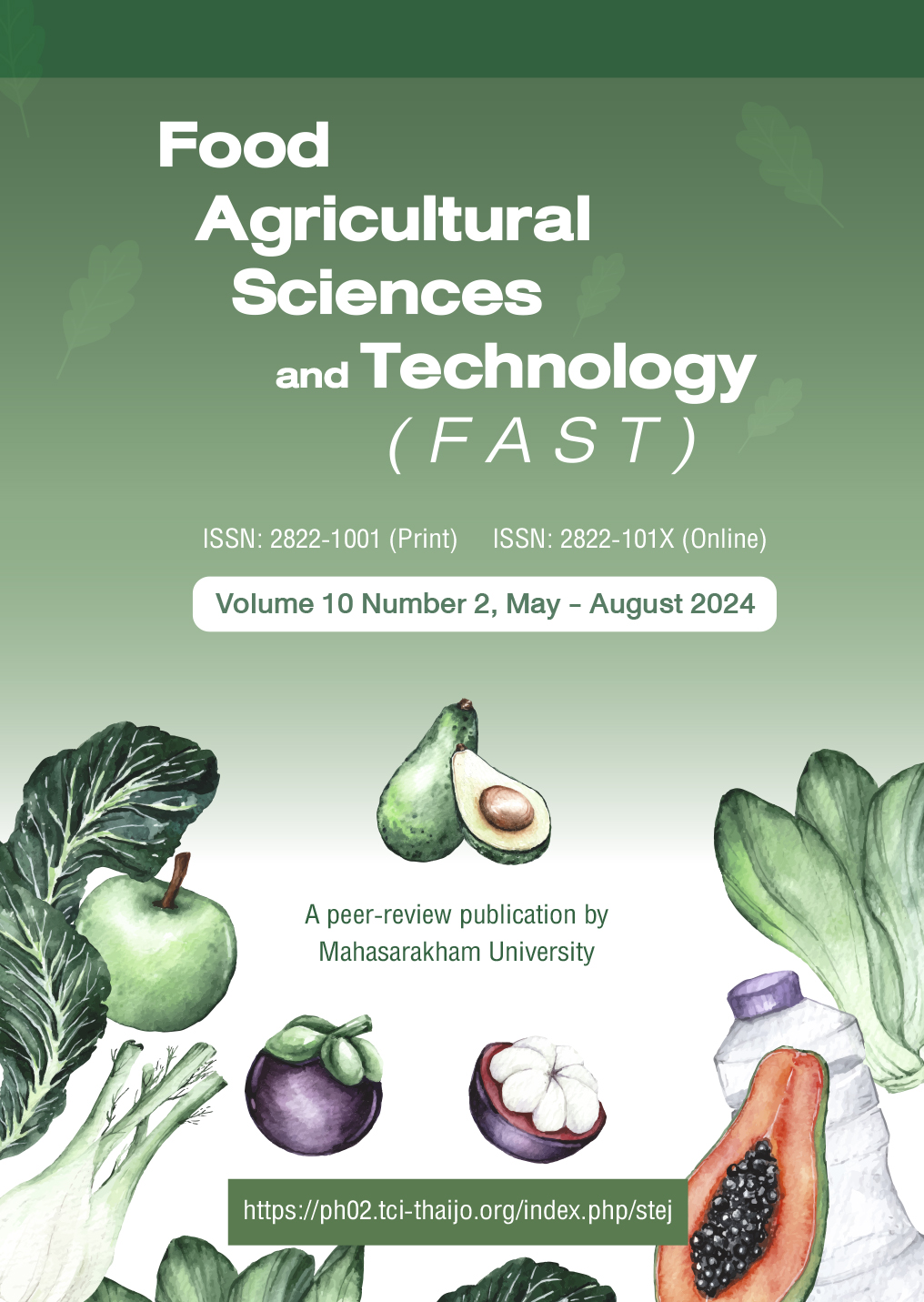Bioconversion of Garcinia mangostana rind extract juice with yeast fermentation: Impact on its key bioactivity
Keywords:
Saccharomyces cerevisiae, yeast, mangosteen peelAbstract
Mangosteen (Garcinia mangostana L.) peel, a by-product of fruit processing, contains bioactive polyphenols with potential health benefits. However, the consumption of mangosteen peel as a supplement is generally limited due to its astringent taste. This study proposed the process for adding value the Garcinia mangostana rind extract juice (GREj) by bioconversion with yeast fermentation. The GREj was extracted by hydraulic pressing machine. The GREj medium was formulated by diluting with water to contain 20% GREj adjusted total soluble solids (TSS) with sugar to 12.00 °Brix and pH to 4.00 with lactic acid. After fermentation 3L of GREj medium with Saccharomyces cerevisiae in 5L bioreactor, the composition of GREj evaluated through HPLC (High Performance Liquid Chromatography) and TLC (thin layer chromatography) were significantly changed. The main acid of GREj, acetic acid was found greater than citric acid, the migration pattern on TLC with retention factor (Rf) was changed from 0.24 to 0.26. The antioxidant; DPPH (2,2-diphenyl-1-picrylhydrazyl) and TPC (total phenolic content) demonstrated the significant improvement of the GREj antioxidant capacity. The fermented GREj had intense red-purple color with fermented aroma and sour taste. This fermented juice could be further developed to be a functional drink as well as processed to be a powder form to use as functional ingredient and/or supplement. This demonstrated that yeast fermentation could be a potential mean in value adding of mangosteen peel from being agricultural waste to functional beverages and meals.
References
Adiningsih, A. D., Ramadhan, M. Y. A., Darmawan, M. A., & Gozan, M. (2022). Mangosteen rind (Garcinia mangostana Linn) fermentation with Saccharomyces cerevisiae yeast to increase antioxidant level. AIP Conference Proceedings, 2493(1). https://doi.org/10.1063/5.0130363
Buranavanitvong, N., & Prakitchaiwattana, C. (2022). Growth profiels of probiotic yeast (Saccharomyces boulardii) in different culture media; fruit, vegetable juices, and standard media for development of alternative culture substrate in probiotic cell production. Chulalongkorn University.
Chanprasartsuk, O., Prakitchaiwattana, C., Sanguandeekul, R., & Fleet, G. H. (2010). Autochthonous yeasts associated with mature pineapple fruits, freshly crushed juice and their ferments; and the chemical changes during natural fermentation. Bioresource Technology, 101(19), 7500-7509. https://doi.org/10.1016/j. biortech.2010.04.047
Detudom, R., Deetae, P., Wei, H., Boran, H., Chen, S., Siriamornpun, S. & Prakitchaiwattana, C. (2023). Dynamic changes in physicochemical and microbiological qualities of coconut water during postharvest storage under different conditions. Horticulturae, 9(12),1284. https://doi. org/10.3390/horticulturae9121284
Fu, J., Liu, J., Wen, X., Zhang, G., Cai, J., Qiao, Z., An, Z., Zheng, J., & Li, L. (2023). Unique probiotic properties and bioactive metabolites of Saccharomyces boulardii. Probiotics and Antimicrobial Proteins, 15(4), 967-982. https://doi.org/10.1007/ s12602-022-09953-1
Gondokesumo, M. E. (2019). Xanthones analysis and antioxidant activity analysis (Applying ESR) of six different maturity levels of mangosteen rind extract (Garcinia mangostana Linn.). Pharmacognosy Journal, 11(2), 369-373. http://repository. ubaya.ac.id/id/eprint/34735
Iswari, K. (2011). Kulit manggis berkhasiat tinggi. Madya Centradifa.
Jayaram, V. B., Cuyvers, S., Verstrepen, K. J., Delcour, J. A., & Courtin, C. M. (2014). Succinic acid in levels produced by yeast (Saccharomyces cerevisiae) during fermentation strongly impacts wheat bread dough properties. Food Chemistry, 151, 421-428. https://doi.org/10.1016/j. foodchem.2013.11.025
Larasati, F., Batubara, I., & Lestari, Y. (2020). The presence of endophytic actinobacteria in mangosteen peel (Garcinia mangostana) and its antioxidant activity. Biodiversitas Journal of Biological Diversity, 21(4). https://doi.org/10.13057/ biodiv/d210429
Niamah, A. K. (2017). Physicochemical and microbial characteristics of yogurt with Added Saccharomyces boulardii. Current Research in Nutrition and Food Science Journal, 5(3), 300-307. https:// doi.org/10.12944/CRNFSJ.5.3.15
Palakawong, C., & Delaquis, P. (2018). Mangosteen processing: A review. Journal of Food Processing and Preservation, 42(10). https://doi. org/10.1111/jfpp.13744
Rantsiou, K., Dolci, P., Giacosa, S., Torchio, F., Tofalo, R., Torriani, S., Suzzi, G., Rolle, L., & Cocolin, L. (2012). Candida zemplinina can reduce acetic acid produced by Saccharomyces cerevisiae in sweet wine fermentations. Applied and Environmental Microbiology, 78(6), 1987-1994. https://doi.org/10.1128/ aem.06768-11
Santiago, M., & Strobel, S. (2013). Thin layer chromatography. In Methods in enzymology (pp. 303-324). Elsevier. https://doi.org/10.1016/ B978-0-12-420067-8.00024-6
Shimada, K., Fujikawa, K., Yahara, K., & Nakamura, T. (1992). Antioxidative properties of xanthan on the autoxidation of soybean oil in cyclodextrin emulsion. Journal of Agricultural and Food Chemistry, 40(6), 945-948. https:// doi.org/10.1021/jf00018a005
Suazo, Y., Davidov-Pardo, G., & Arozarena, I. (2014). Effect of fermentation and roasting on the phenolic concentration and antioxidant activity of cocoa from N icaragua. Journal of Food Quality, 37(1), 50-56. https://doi.org/10.1111/ jfq.12070
Sun, T.-Y., Li, J.-S., & Chen, C. (2015). Effects of blending wheatgrass juice on enhancing phenolic compounds and antioxidant activities of traditional kombucha beverage. Journal of Food and Drug Analysis, 23(4), 709-718. https:// doi.org/10.1016/j.jfda.2015.01.009
Wei, L., Li, Y., Hao, Z., Zheng, Z., Yang, H., Xu, S., Li, S., Zhang, L., & Xu, Y. (2023). Fermentation improves antioxidant capacity and γ-aminobutyric acid content of Ganmai Dazao Decoction by lactic acid bacteria. Frontiers in Microbiology, 14, 1274353. https:// doi.org/10.3389/fmicb.2023.1274353
Widowati, W., Darsono, L., Suherman, J., Yelliantty, Y., & Maesaroh, M. (2014). High performance liquid chromatography (HPLC) analysis, antioxidant, antiaggregation of mangosteen peel extract (Garcinia mangostana L.). International Journal of Bioscience, Biochemistry and Bioinformatics, 4(6), 458. https://doi.org/10.17706/ijbbb. 2014.4.6.458-466
Widowati, W., Ginting, C. N., Lister, I. N. E., Girsang, E., Amalia, A., Wibowo, S. H. B., & Kusuma, H. S. W. (2020). Anti-aging effects of mangosteen peel extract and its phytochemical compounds: Antioxidant activity, enzyme inhibition and molecular docking simulation. Tropical Life Sciences Research, 31(3), 127. https://doi. org/10.21315%2Ftlsr2020.31.3.9
Downloads
Published
How to Cite
Issue
Section
License
Copyright (c) 2024 Food Agricultural Sciences and Technology

This work is licensed under a Creative Commons Attribution-NoDerivatives 4.0 International License.








